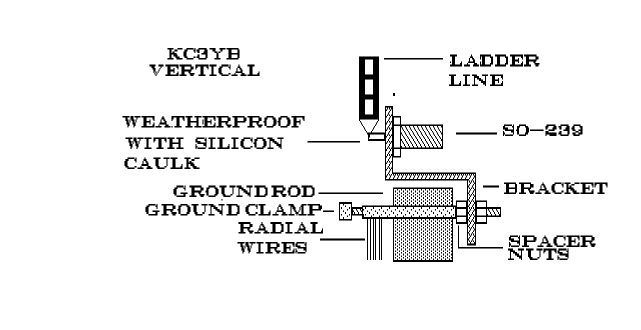Build an 80/40 Meter Vertical
This antenna will not work for everyone, but if circumstances allow you to use it, you will find it a top DX performer, and at a reasonable price. It is a little different from most vertical antenna, for these frequencies anyway. There’s the rub – if you have access to a skyhook, or at least a tall tree, it will serve you well.
The dual band nature of the antenna is a result of the construction of the radiating element, which is merely a length of two-conductor ‘ladder line’. Starting with a piece about seventy feet long, remove 34 feet of one conductor, along with the insulation between the insulation between the two conductors. Leave the insulation on the other conductor. At the other end, remove the insulation from about 3/4 inch of both conductors and solder them together. This constitutes the radiating elements, which are somewhat long for either band. They will be pruned before actual use.

Select a spot for your vertical and drive an eight foot ground rod to within 6″ of the surface. Attach a ground clamp, as shown, then position two nuts on the bolts holding the clamp together. Attach the antenna base, holding it in place with two more nuts, and solder the ladder line to the coaxial connector.
Attach an insulator to the top of the wire and pull the antenna to its vertical position to get it out of your way. This is easily done by means of a weighted line thrown over the top of the tree. As this is a quarter wave vertical antenna, installation of a radial system is necessary.
In order to minimize ground loss, it is essential that a radial system be installed. Ideally, this should be comprised of 120 wires, each 1/4 wavelength long, positioned on the surface of the ground (or just below the surface), and reaching in all directions. In practice, use as many as you can, and positioned where you are able. Bear in mind the performance of the antenna system will be dramatically affected by the quality of your radial system.
Using an antenna noise bridge, cut the radiating elements to the optimum length. This will require raising and lowering the antenna repeatedly, but it isn’t that much trouble. Ideally, you should prune both elements at once, as the length of one will affect the other to some degree. This length adjustment can be done with an SWR meter, but it is a lot more trouble and causes QRM, to boot.
In my own experience, I have found that this two-band vertical works amazingly well, especially considering the cost. I have worked Yugoslavia, Sweden, and many other DX and domestic stations barefoot, and am quite pleased with the results.
Originally posted on the AntennaX Online Magazine by John R. Somers, KC3YB
Last Updated : 6th March 2024
